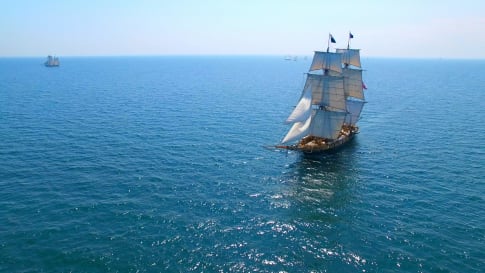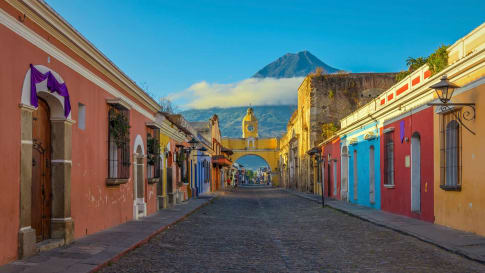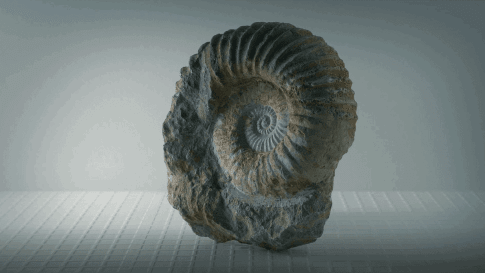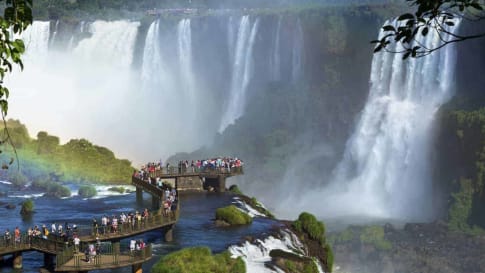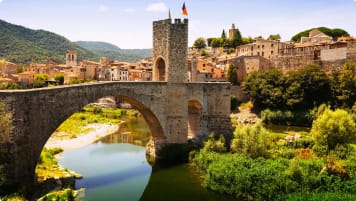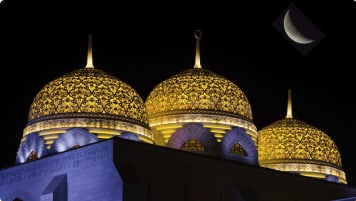Journey through Central America: Panama, Costa Rica, Honduras, and Guatemala
Join Odyssey Traveller as we go on a 27-day small group journey for mature and senior couples and solo travellers across Central America, exploring the history and diverse scenery of Panama, Costa Rica, Honduras, and Guatemala.
From $25,391NZD
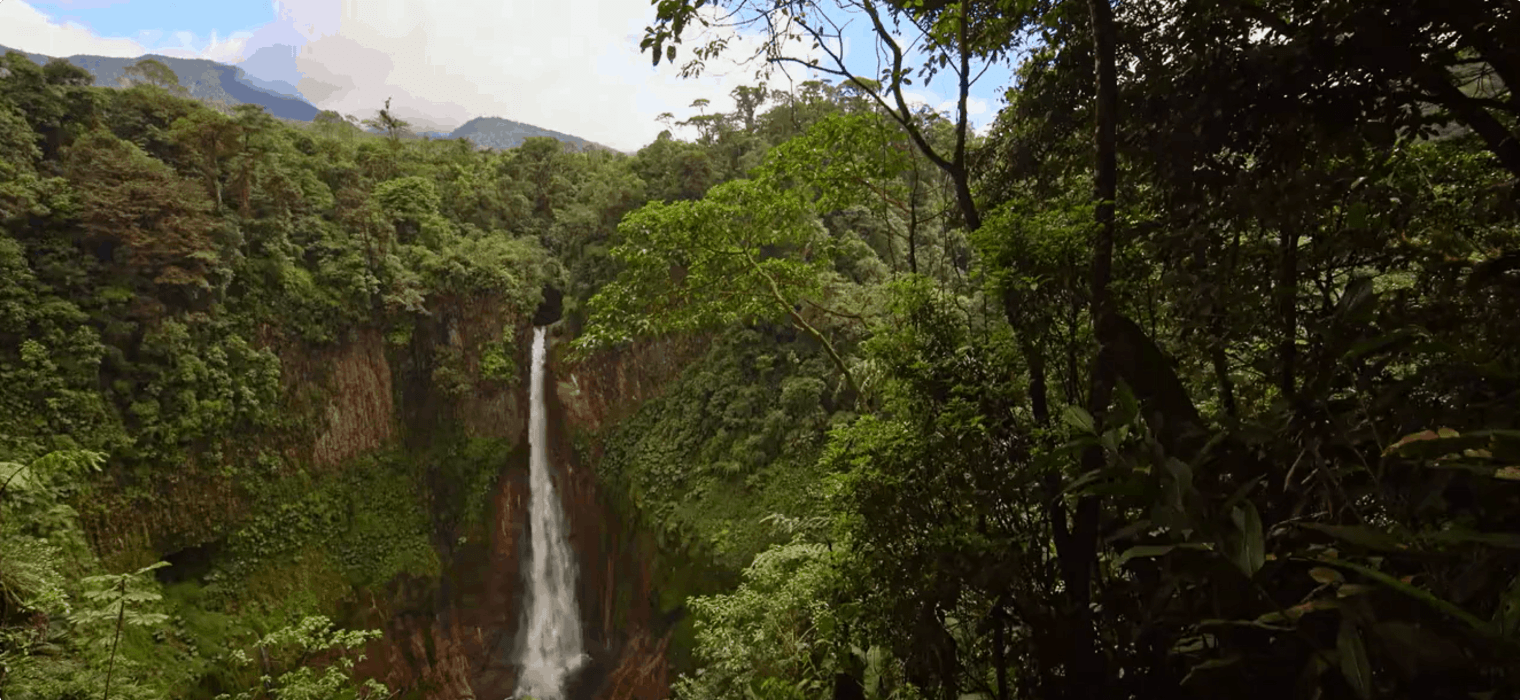
Highlights
- 1. Experience Costa Rica's natural wonders at the La Paz Waterfall Gardens, Tortuguero National Park, Lake Arenal, and the misty cloud forest of Monteverde.
- 2. Visit the beautiful city of Antigua Guatemala ("Old Guatemala"), its horizon dominated by three majestic volcanoes.
- 3. Explore the shores of Lake Atitlan, the deepest lake in Central America located in the Guatemalan Highlands, and renowned as the most beautiful lake in the world.
- 4. Cross the border into Honduras and visit the town of Copan, an important archaeological site concerning the ancient Maya civilisation.
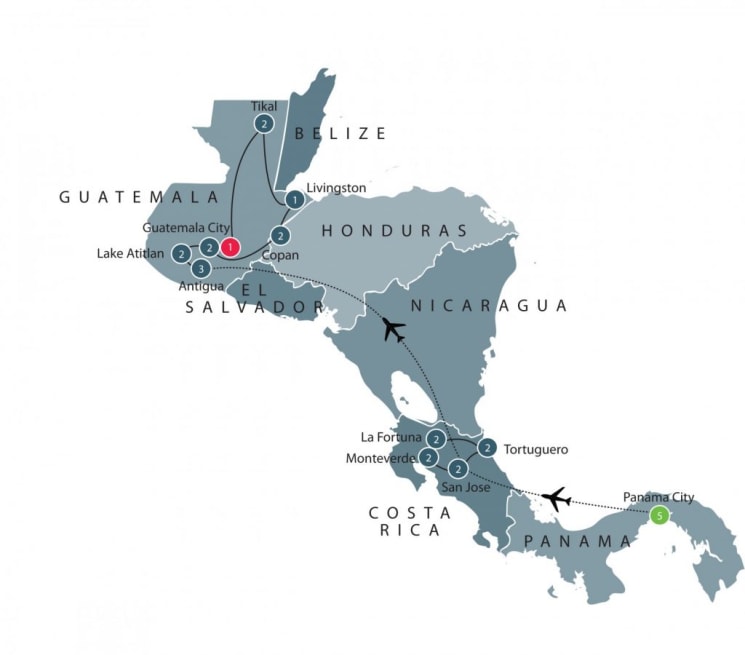
Departure Dates
| Departure Date | Price |
|---|---|
| 21 October 2025 Ends 16 November 2025 • 27 days $25,391 Twin $28,732 Single Available | Selected |
| 20 April 2026 Ends 16 May 2026 • 27 days $26,149 Twin $30,242 Single Available | |
| 20 October 2026 Ends 15 November 2026 • 27 days $26,149 Twin $30,242 Single Available | |
| 19 April 2027 Ends 15 May 2027 • days $26,149 Twin $30,242 Single Available | |
| 18 October 2027 Ends 13 November 2027 • days $26,149 Twin $30,242 Single Available |
Journey through Central America
Join Odyssey Traveller as we go on a 27-day journey across Central America, exploring Panama, Costa Rica, Honduras, and Guatemala. A thread connecting the histories of these countries is the ancient Maya civilisation, which ruled an empire centred in what is now Guatemala. Possessing one of the greatest and most advanced civilisations in the Western Hemisphere, the Maya Empire at the height of its power ruled Mesoamerica (Mexico and Central America) before the Spanish conquest in the 16th century. The ancient ruins of the Mayan civilization continue to dot the landscape as important archaeological sites, which we will explore on these small group guided tours in Central America.
A common colonial past and breathtaking and diverse scenery also unite the countries we will visit. We will learn more about their histories, ancient culture, and natural beauty--their Maya ruins, national park, and active volcanoes--over the course of 27 days. On this small group adventure, we will visit not only the countries' colonial cities and colonial towns, but also their smaller villages that other commercial tours may not include on their itineraries, giving you a fuller cultural and historical picture of the region.
Like our other group tours, our escorted tours in Central America features an Odyssey Program Leader and a handful of local guides who will impart their knowledge about the destinations we visit.
Highlights of our Central America Small Group Tour
Panama
With the bustling city of Panama as a jump-off point, we will go on a boat cruise to take a closer look at one of the greatest engineering feats in modern history, the Panama Canal. We will also visit Casco Viejo ("old quarter", also called Casco Antiguo), a neighbourhood in Panama City inscribed on the UNESCO list of World Heritage Sites, and which was established in 1673 by Spanish colonisers and other settlers. We will also visit the community of the indigenous Emberá tribe, who have been living in the region even before "Panama" as a state was formed.
Costa Rica
Our next stop is Costa Rica. In the tobacco centre of San Jose, we will explore the Doka coffee plantation to learn the process of cultivating and processing coffee, which was the country's chief source of income throughout the 19th century. We then experience Costa Rica's natural wonders at the La Paz Waterfall Gardens, followed by Tortuguero National Park, Lake Arenal, and the misty cloud forest of Monteverde.
Guatemala
We then head to Guatemala, once the centre of ancient Mayan civilisation. We visit the beautiful city of Antigua, inscribed on the UNESCO World Heritage List since 1979. Its full name, "Antigua Guatemala", means Old Guatemala, and here we can see preserved Mayan ruins and monuments dating back to the 16th century. Its horizon is dominated by three majestic volcanoes.
We go to the shores of Lake Atitlan, the deepest lake in Central America located in the Guatemalan Highlands. It has been renowned as the most beautiful lake in the world, surrounded by volcanoes and wildflowers. The lake is also surrounded by villages wherein Maya culture remains strong, displayed proudly through the people's traditional dress.
Also in Guatemala, we will go on an hour-long scenic drive through the highlands to the town of San Juan Comalapa, which became famous for its indigenous Kaqchikel painters and the town of Santo Tomas Chichicastenango ("city of nettles"), centre of K'iche' Maya culture.
Honduras
We briefly cross the border into Honduras, where we visit the town of Copan, occupied for more than two thousand years and now an important archaeological site concerning the Maya civilisation in ancient times.
Back to Guatemala
We continue our journey by boat to Livingston, surrounded by verdant forests and water and which has no land link to the rest of Guatemala. This is a settlement of the Afro-Caribbean Garifuna people, descendants of the slave trade who founded a rich cultural heritage in the city.
Finally, we head to the breathtaking ruins of Tikal, declared a World Heritage Site in 1979. We will explore this sprawling complex founded in the heart of tropical rainforests, and view the huge temples rising above the forest canopy. This is an incredible place to conclude our multi-week tour of Central America.
For more details, click the ‘Top 5’ or ‘Itinerary’ buttons above! If you’re keen to experience this tour, please call or send an email. Or, to book, simply fill in the form on the right-hand side of this page.
After visiting the Mayan ruins, you may also be interested to learn about the Incan civilization and see Machu Picchu through these tours:
All of Odyssey Traveller tours are especially designed for the mature-aged or senior traveller, whether travelling alone or with a companion and keen to engage in this small group travel style. Explore our many wonderful adventure tours and sign up! We also have more information on Panama, Costa Rica, Honduras and Guatemala.
External articles to assist you on your visit to Panama and Central America:
The following external links may help you in planning your visit to Central America.
- Central America Travel
- Central America History
- Cloud forest | ecology | Britannica.com
- Central America travel guide – which is the perfect country for you?
For more information on Odyssey Traveller and our educational small group tours, visit and explore our website, and remember to visit these pages in particular:
- Terms and conditions applicable for booking an Odyssey Traveller tour.
- FAQ's about Odyssey Traveller
Alternatively, please call or send an email.
Gallery
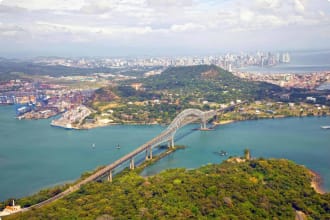

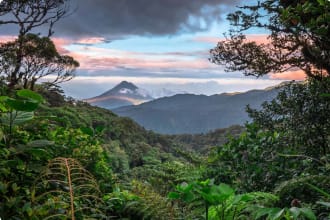
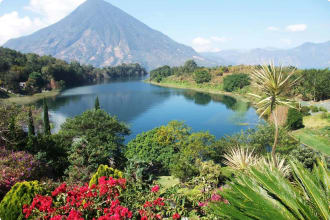
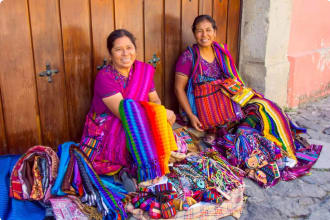
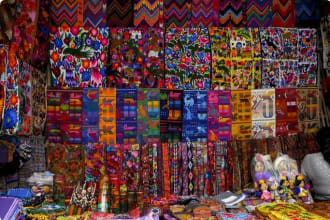
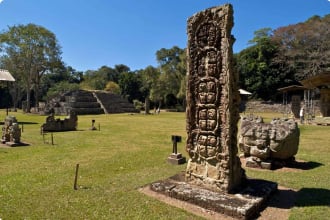
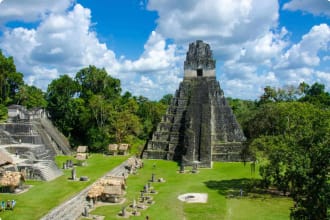

Itinerary
27 days
Day 1: Panama City
Accommodation: Le Meridien Hotel or similar
Upon arrival in Panama, we make our own way to our hotel. The Odyssey Program Leader will greet the group and the rest of the day is free until we meet again in the evening for our welcome dinner.
Day 2: Panama City - Casco Viejo
Accommodation: Le Meridien Hotel or similar
Today we will be touring the historic and cultural centre of Panama. Casco Viejo (“old quarter”, also called Casco Antiguo), a neighbourhood in Panama City, has been inscribed on the UNESCO list of World Heritage Sites since 1997. Casco Viejo was established in 1673 by Spanish colonisers and other settlers, and experienced neglect, poverty, and gang violence before finally undergoing restoration in recent years. We will walk around the old quarter to view the colonial buildings and experience its museums and restaurants. We will continue to the Miraflores Locks to view the Panama Canal. The Panama Canal, completed in 1914, is a man-made waterway connecting the Atlantic and Pacific Oceans through the narrow Isthmus of Panama. Ships travelling through the canal save a lot of time–for example, ships sailing between the east and west coasts of the United States need only go through the canal instead of rounding Cape Horn in South America.
Day 3: Panama City
Accommodation: Le Meridien Hotel or similar
Today we will visit the community of the indigenous Emberá tribe, who have been living in the region even before “Panama” as a state was formed. This tour will give us an opportunity to know more about their culture and history.
Day 4 : Panama City
Accommodation: Le Meridien Hotel or similar
Having viewed the Panama Canal on Day 2, today we will be taking a closer look at this engineering feat. From the Pacific coast, we take a voyage through the Miraflores Locks, Pedro Miguel, and the Gaillard Cut. We disembark in Gamboa, and travel by land to Colon on the Atlantic Coast. At Colon, we travel via the Panama Canal Railway, the world’s first Trans-Continental rail route, which will take us through lush rainforests across the Isthmus of Panama and back to the city.
Day 5: Panama City
Accommodation: Le Meridien Hotel or similar
Today is a free day! Use this time to rest or explore the area near our accommodation. You can also use this time to pack as we will be flying out of Panama tomorrow.
Day 6: Panama City - San Jose
Accommodation: Presidente Hotel or similar
Today we fly from Panama City to the city of San Jose, capital and largest city of Costa Rica. Founded by the cabildo (legal representative of the Spanish Crown) in 1736, San Jose became a tobacco centre and in the 1840s a centre of coffee production. Coffee remained a chief export of Costa Rica and its largest source of income throughout the 19th century. With this history in mind, upon arrival, we commence the tour by exploring the Doka coffee plantation to learn the process of cultivating and processing coffee. We then experience Costa Rica’s natural wonders at the La Paz Waterfall Gardens, viewing the beautiful Magia Bianca Waterfall and the Butterfly Observatory.
Day 7: San Jose – Tortuguero
Accommodation: Evergreen Lodge or similar
After breakfast, we take a drive northeast to the Caribbean side of Costa Rica to visit the Tortuguero National Park. Tortuguero means “turtle catcher”, and the park indeed is an important hatchery in the western Caribbean for green sea turtles, and a nesting place for three other turtle species. Species diversity in Tortuguero National Park is among the highest in Costa Rica, due to the diversity of the habitats within its reserve. Tortuguero is not accessible by road, so the final part of our journey will be by boat. We will stay at our accommodation in the area, and go on a river safari in the early evening. Please note that the park will be warm with high humidity, so dress accordingly!
Day 8: Tortuguero
Accommodation: Evergreen Lodge or similar
We continue our exploration of the Tortuguero National Park to experience its abundant wildlife and vegetation. The park is home to 57 species of amphibians, 111 species of reptiles, 60 species of mammals and more than 300 species of birds for all or part of the year–which makes for an exciting day of exploration.
Day 9: Tortuguero - Lake Arenal - La Fortuna
Accommodation: Arenal Kioro Hotel or similar
We leave Tortuguero and drive to the shores of Lake Arenal, Costa Rica’s largest landlocked body of water. With a surface covering nearly 85 square kilometres (33 square miles), the lake sits at the base of Arenal Volcano in the northern highlands. We cross the lake by boat and travel on the road to the town of La Fortuna. The rest of the day is at leisure. At our accommodation, we can enjoy views of the volcano and relax.
Day 10: La Fortuna
Accommodation: Arenal Kioro Hotel or similar
The Arenal Volcano stands 1,633 metres (5,358 ft) high, towering over its surroundings. Currently dormant, the volcano was Costa Rica’s most active volcano until 2010. Today we will have a chance to move closer and explore the forest surrounding Arenal Volcano.
Day 11: La Fortuna - Monteverde
Accommodation: El Establo Hotel and similar
After breakfast, we cross the Arenal Lake to the small community of Monteverde.
Day 12: Monteverde
Accommodation: El Establo Hotel or similar
Today we will be exploring the Monteverde Cloud Forest Biological Reserve, founded in 1972 and home to half of Costa Rica’s flora and fauna and 2.5 percent of the world’s biodiversity. A “cloud forest” is called as such due to the mists produced by the cooling of wet air currents in the mountains. Sitting at an elevation of 1,600 metres above sea level, the reserve is also mist-covered, and we will experience the same dreamlike atmosphere as we cross the skywalk through the forest canopy.
Day 13: Monteverde - Selvatura Park - San Jose
Accommodation: Holiday Inn Express Forum Hotel or similar
Still in Monteverde, we visit another ecological reserve, Selvatura Park. We can walk across the Treetop Walkways to give us fantastic views of the cloud forest. After lunch, we drive to San Jose.
Day 14: San Jose - Guatemala City - Antigua
Accommodation: El Convento Boutique Hotel or similar
This morning, we transfer to the San Jose airport for our flight to Guatemala City. Upon arrival in Guatemala City, we travel by road to the beautiful city of Antigua, where we will check into our accommodation.
Day 15: Antigua
Accommodation: El Convento Boutique Hotel or similar
The beautiful city of Antigua in Guatemala has been inscribed on the UNESCO World Heritage List since 1979. Its full name, “Antigua Guatemala”, means Old Guatemala, and here you can see preserved ruins and monuments dating back to the 16th century when it served as capital of the Kingdom of Guatemala. Its horizon is dominated by three majestic volcanoes. In the morning we will enjoy a guided walking tour of Antigua, and have the rest of the day free to spend at our leisure.
Day 16: Antigua - San Miguel Escobar - Antigua
Accommodation: El Convento Boutique Hotel or similar
Brightly coloured chicken buses (modified buses) ply the roads of Antigua, and we will board one for our journey to San Miguel Escobar. We transfer to 4WDs for a short ride to coffee fields to learn about coffee production and also take part in coffee picking. We will enjoy lunch with a local family before heading back to our hotel in Antigua.
Day 17: Antigua - Comalapa - Lake Atitlan
Accommodation: Hotel Atitlan or similar
After breakfast, we go on an hour-long scenic drive through the highlands to the town of San Juan Comalapa, which became famous for its indigenous Kaqchikel painters. Kaqchikel painter Andrés Curruchich (1891–1969) made oil paintings depicting village life and traditions, and gained international renown. He then decided to teach a new generation of Kaqchikel artists. We will take a tour of the town’s local market, which also display paintings and murals of the local artists. After lunch, we continue on to Lake Atitlan, which we will explore in the next few days. The rest of the day can be spent at our leisure.
Day 18: Lake Atitlan
Accommodation: Hotel Atitlan or similar
Lake Atitlan (“between the waters”), located in the Guatemalan Highlands, is the deepest lake in Central America. It has been renowned as the most beautiful lake in the world, surrounded by volcanoes and wildflowers. The lake is surrounded by villages wherein Maya culture remains strong, displayed proudly through the people’s traditional dress. Today we will go on a leisurely cruise and visit a number of these villages and communities.
Day 19: Lake Atitlan - Chichicastenango - Guatemala City
Accommodation: Westin Camino Real or similar
We leave Lake Atitlan and continue on to the town of Santo Tomas Chichicastenango (“city of nettles”). The town is the centre of K’iche’ Maya culture–a huge majority of the residents belong to the K’iche, who speak both their indigenous language and Spanish. Chichicastenango hosts market days twice a week (Thursdays and Sundays) where traders from all over Guatemala sell their goods. We will take part in this vibrant atmosphere and see the textiles, pottery, and flowers, among others, on display. After lunch we drive to Guatemala City.
Day 20: Guatemala City
Accommodation: Westin Camino Real or similar
In 1773, Antigua Guatemala (which we have visited earlier) was destroyed by an earthquake, prompting the creation of a new centre. That city became Guatemala City, capital of the captaincy general of Guatemala in 1776 until it became the capital of the independent Republic of Guatemala in the 19th century. Guatemala City is the economic and cultural heart of Guatemala, and today we will have a walking tour to take in its colonial architecture and Mayan history narrated by its art galleries.
Day 21: Guatemala City - Copan
Accommodation: Marina Copan Hotel or similar
After breakfast, we begin our five-hour journey to the border between Guatemala and Honduras. Near the Guatemala-Honduras border is the town of Copan, occupied for more than two thousand years and now an important archaeological site of Mayan civilisation. After lunch at our hotel, we visit Macaw Mountain, a bird rescue, rehabilitation and release centre.
Day 22: Copan
Accommodation: Marina Copan Hotel or similar
Today, we will continue our exploration of the ancient Mayan world in Copan. Copan was once a powerful city ruling a kingdom in the western Honduras, and we will be able to view its ruins and learn more about its history today.
Day 23: Copan - Quirigua - Livingston
Accommodation: Hotel Villa Caribe or similar
We cross the border back into Guatemala and visit the UNESCO World Heritage Site of Quirigua, another ancient Maya archaeological site. Its monuments, carved stelae and sculpted calendars are important in providing insight to Mayan civilisation. After exploring the site, we transfer to Puerto Barrios (Guatemala’s main Caribbean Sea port) for our transfer by boat to the town of Livingston, where we will stay for the night.
Day 24: Livingston - Tikal
Accommodation: Jungle Lodge or similar
This morning we explore Livingston. Livingston is surrounded by verdant forests and water and sits at the mouth of the Río Dulce at the Gulf of Honduras, with no road connection to the rest of Guatemala. This is a settlement of the Afro-Caribbean Garifuna people, who founded a rich cultural heritage in the city. We enjoy a boat tour on the Rio Dulce, and after lunch we journey north to the Mayan city of Tikal.
Day 25: Tikal
Accommodation: Jungle Lodge or similar
Tikal is located in the ruins of an ancient and great Mayan city, declared a World Heritage Site in 1979. We will explore this sprawling complex founded in the heart of a rainforest, and view the huge temples rising above the forest canopy. This is an incredible place to conclude our multi-week tour of Central America.
Day 26: Tikal - Flores - Guatemala
Accommodation: Westin Camino Real or similar
This morning we transfer to the airport for our flight to Guatemala City. We will enjoy our final night with a farewell dinner to look back on the amazing sights we’ve experienced together on this tour.
Day 27: Guatemala City
Our tour and our services conclude after breakfast.
Includes / Excludes
What’s included in our Tour
- 26 nights hotel accommodation.
- 26 Breakfasts, 10 lunches plus 1 boxed Lunch, and 21 dinners.
- 3 internal flights including taxes (economy class)
- Transport by coach.
- All sightseeing tours applicable to the itinerary, including entrance fees.
- Service charges and gratuities.
- Services of an Odyssey tour leader.
- English speaking local guides.
- Detailed tour information.
What’s not included in our Tour
- Return international airfares including taxes.
- Items of a personal nature such as telephone calls and laundry.
- Comprehensive travel insurance.
- Visas where required to visit each country.
Participants must be able to carry their own luggage, climb and descend stairs, be in good health, mobile and able to participate in 3-5 hours of physical activity per day, the equivalent of walking / hiking up to 8 kilometers per day on uneven ground.
Book now
Make it a private tour
Easing your journey
Crossing international borders with restrictions
The list of requirements to travel internationally has changed and will continue to change for several years. Odyssey is here to assist you in managing your way through these requirements:
For more information see our Crossing international borders with restrictions page.
Book With Confidence
If less than 30 days before your tour starts you are unable to travel as a result of Government travel restrictions, Odyssey Traveller will assist you with a date change, provide you with a credit or process a refund for your booking less any non-recoverable costs.
See Terms and conditions for details.
Peace of Mind Travel
The safety of our travellers, tour leader, local guide and support staff has always been our top priority and with the new guidelines for public health and safety for keeping safe for destinations around the world, we’ve developed our plan to give you peace of mind when travelling with us.
See Peace of Mind Travel for details.
Reading List Download PDF
The Path Between the Seas: The Creation of the Panama Canal, 1870-1914
David McCullough
The National Book Award–winning epic chronicle of the creation of the Panama Canal, a first-rate drama of the bold and brilliant engineering feat that was filled with both tragedy and triumph, told by master historian David McCullough.
From the Pulitzer Prize–winning author of Truman, here is the national bestselling epic chronicle of the creation of the Panama Canal. In The Path Between the Seas, acclaimed historian David McCullough delivers a first-rate drama of the sweeping human undertaking that led to the creation of this grand enterprise.
The Path Between the Seas tells the story of the men and women who fought against all odds to fulfill the 400-year-old dream of constructing an aquatic passageway between the Atlantic and Pacific oceans. It is a story of astonishing engineering feats, tremendous medical accomplishments, political power plays, heroic successes, and tragic failures. Applying his remarkable gift for writing lucid, lively exposition, McCullough weaves the many strands of the momentous event into a comprehensive and captivating tale.
Winner of the National Book Award for history, the Francis Parkman Prize, the Samuel Eliot Morison Award, and the Cornelius Ryan Award (for the best book of the year on international affairs), The Path Between the Seas is a must-read for anyone interested in American history, the history of technology, international intrigue, and human drama.
Modern Panama: From Occupation to Crossroads of the Americas
Michael L. Conniff and Gene E. Bigler
Few have a complete understanding of the recent history of Panama, markedly since the signing of the Carter-Torrijos Treaties in 1977. Although the Treaty set the stage for the country to finally control all of its territory, little is known about how Panama has fared, both as a manager of a major waterway and as a sovereign nation in a unique region. Authors Michael L. Conniff and Gene E. Bigler seek to fill this major gap in Latin American history with Modern Panama, a thorough account of the recent political and economic developments in Panama. Despite the country's continued struggle with political corruption, Conniff and Bigler argue that changes since the turnover of the Canal have been largely positive, and Panama has emerged into the twenty-first century as a stable, functioning democracy with a growing economy, improved canal management, and a higher standard of living.
Panama History: The Conquest, The Spanish Colony, The War Years, The Society and Its Environment, Ethnic Groups, The Economy, Government
Uzo Marvin
Panama history and early settlement, Panama Society and Its Environment, Panama Ethnic Groups, Panama Migration, Panama Education, Panama Health and Welfare, Panama Foreign Economic Relations, Panama Government, Panama tourism, Panama people.Estimates vary greatly of the number of Indians who inhabited the isthmus when the Spanish explorers arrived. By some accounts, the population was considerably greater than that of contemporary Panama. Some Panamanian historians have suggested that there might have been a population of 500,000 Indians from some sixty "tribes," but other researchers have concluded that the Cuna alone numbered some 750,000.Besides the Cuna, which constituted by far the largest group in the area, two other major groups, the Guaymí and the Chocó, have been identified by ethnologists. The Guaymí, of the highlands near the Costa Rican border, are believed to be related to Indians of the Nahuatlan and Mayan nations of Mexico and Central America. The Chocó on the Pacific side of Darién Province appear to be related to the Chibcha of Colombia
The Costa Rica Reader: History, Culture, Politics (The Latin America Readers) The Costa Rica Reader: History, Culture, Politics (The Latin America Readers)
Steven Palmer and Iván Molina
Long characterized as an exceptional country within Latin America, Costa Rica has been hailed as a democratic oasis in a continent scorched by dictatorship and revolution; the ecological mecca of a biosphere laid waste by deforestation and urban blight; and an egalitarian, middle-class society blissfully immune to the violent class and racial conflicts that have haunted the region. Arguing that conceptions of Costa Rica as a happy anomaly downplay its rich heritage and diverse population, The Costa Rica Reader brings together texts and artwork that reveal the complexity of the country’s past and present. It characterizes Costa Rica as a site of alternatives and possibilities that undermine stereotypes about the region’s history and challenge the idea that current dilemmas facing Latin America are inevitable or insoluble.
This essential introduction to Costa Rica includes more than fifty texts related to the country’s history, culture, politics, and natural environment. Most of these newspaper accounts, histories, petitions, memoirs, poems, and essays are written by Costa Ricans. Many appear here in English for the first time. The authors are men and women, young and old, scholars, farmers, workers, and activists. The Costa Rica Reader presents a panoply of voices: eloquent working-class raconteurs from San José’s poorest barrios, English-speaking Afro-Antilleans of the Limón province, Nicaraguan immigrants, factory workers, dissident members of the intelligentsia, and indigenous people struggling to preserve their culture. With more than forty images, the collection showcases sculptures, photographs, maps, cartoons, and fliers. From the time before the arrival of the Spanish, through the rise of the coffee plantations and the Civil War of 1948, up to participation in today’s globalized world, Costa Rica’s remarkable history comes alive. The Costa Rica Reader is a necessary resource for scholars, students, and travelers alike.
Costa Rica: Folk Culture, Traditions, and Cuisine
Jack Donnelly
Traveling and living abroad can be an enriching experience—opening your eyes to different cultures and worldviews. But it can be difficult to access the local culture of a foreign country, especially if you aren’t fluent in its language.
Jack Donnelly’s unique guide introduces English-speaking travelers and expats to Costa Rica’s rich folk culture, traditions, and cuisine, which are often missed by nonlocals. Written as a series of articles so you can selectively read what most interests you, Costa Rica covers local legends, folk beliefs, and traditional festivals, wrapping up with a food reference and glossary.
Anyone can take a surfing vacation to Costa Rica; but with the cultural insight of Jack Donnelly, you can go on a true Costa Rican adventure. Discover a local festival happening during your trip, and read up on its history so you can join in. Learn Costa Rican Spanish vocabulary and surprise the locals with your understanding. Test your sour tolerance with a cas drink. “Come back to life” with the seafood cocktail vuelve a la vida, reputed to cure hangovers and illness.
Offering an inside view from an outsider’s perspective, Jack Donnelly’s guide gives you the key to enter the full “Tico” experience.
History of the Discovery and Conquest of Costa Rica
Fernández Guardia, Ricardo
This work has been selected by scholars as being culturally important, and is part of the knowledge base of civilization as we know it. This work was reproduced from the original artifact, and remains as true to the original work as possible. Therefore, you will see the original copyright references, library stamps (as most of these works have been housed in our most important libraries around the world), and other notations in the work.
This work is in the public domain in the United States of America, and possibly other nations. Within the United States, you may freely copy and distribute this work, as no entity (individual or corporate) has a copyright on the body of the work.
As a reproduction of a historical artifact, this work may contain missing or blurred pages, poor pictures, errant marks, etc. Scholars believe, and we concur, that this work is important enough to be preserved, reproduced, and made generally available to the public. We appreciate your support of the preservation process, and thank you for being an important part of keeping this knowledge alive and relevant.
Cultural Traditions in Honduras (Cultural Traditions in My World)
Rebecca Sjonger
Describes the holidays and festivals celebrated throughout the year in Honduras, including the food, traditions, and costumes.
The Long Honduran Night: Resistance , Terror, and the United States in the Aftermath of the Coup
Dana Frank
This powerful narrative recounts the dramatic years in Honduras following the June 2009 military coup that deposed President Manuel Zelaya, told in part through first-person experiences, layered into deeper political analysis. It weaves together two broad pictures: first, the repressive regime that was launched with the coup, and the ways in which U.S. policy has continued to support that regime; and second, the brave and evolving Honduran resistance movement, with aid from a new solidarity movement in the United States.
Although it is full of terrible things, this is not a horror story: the book directly counters mainstream media coverage that portrays Honduras as a pit of unrelenting awfulness, in which powerless people sob in the face of unexplained violence. Rather, it’s about sobering challenges with roots in political processes, and the inspiring collective strength with which people face them
Honduras (Discovering Central America: History, Politics, and Culture)
Charles J. Shields
Introduces Honduras, describing its history, politics, culture, and geography.
Paper Cadavers: The Archives of Dictatorship in Guatemala (American Encounters/Global Interactions)
Kirsten Weld
In Paper Cadavers, an inside account of the astonishing discovery and rescue of Guatemala's secret police archives, Kirsten Weld probes the politics of memory, the wages of the Cold War, and the stakes of historical knowledge production. After Guatemala's bloody thirty-six years of civil war (1960–1996), silence and impunity reigned. That is, until 2005, when human rights investigators stumbled on the archives of the country's National Police, which, at 75 million pages, proved to be the largest trove of secret state records ever found in Latin America.
The unearthing of the archives renewed fierce debates about history, memory, and justice. In Paper Cadavers, Weld explores Guatemala's struggles to manage this avalanche of evidence of past war crimes, providing a firsthand look at how postwar justice activists worked to reconfigure terror archives into implements of social change. Tracing the history of the police files as they were transformed from weapons of counterinsurgency into tools for post-conflict reckoning, Weld sheds light on the country's fraught transition from war to an uneasy peace, reflecting on how societies forget and remember political violence.
Mayan Folktales: Folklore from Lake Atitlán, Guatemala
James D. Sexton
This collection of folklore offers a rich and lively panorama of Mayan mythic heritage. Here are everyday tales of village life; legends of witches, shamans, spiritualists, tricksters, and devils; fables of naguales, or persons who can change into animal forms; ribald stories of love and life; cautionary tales of strange and menacing neighbors and of the danger lurking within the human heart. These legends narrate origin and creation stories, explain the natural world, and reinforce cultural beliefs and values such as honesty, industriousness, sharing, fairness, and cleverness. Whether tragic or comic, fantastic or earthy, whimsical or profound, these tales capture the mystery, fragility, and power of the Mayan world.



